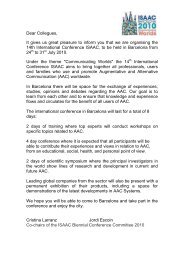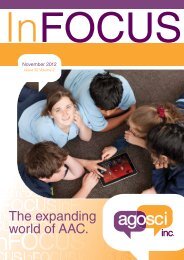May 2008 Edition - agosci
May 2008 Edition - agosci
May 2008 Edition - agosci
Create successful ePaper yourself
Turn your PDF publications into a flip-book with our unique Google optimized e-Paper software.
ccommunicationo m m u n i c a t i o nppartnersa r t n e r sReflections of a Medical Student... (cont)provide the medical practitioner with the detailed informationrequired for an accurate medical assessment. In these cases itcan be very diffi cult or impossible for the medical practitionersto get a comprehensive overview of the health issues of thepatient.In consultations in which the dialogue primarily occursbetween the medical practitioner and the carer, it has beenrecommended that at least some of parts of the conversationshould still be directed towards the patient (Iacono & Johnson,2004; Ziviani et al., 2004). Some people with intellectualdisabilities have better receptive communication skills thandemonstrated expressive communication skills and hence mayrespond to parts of the conversation or even to accompanyingnonverbal communication of the medical practitioner. Peoplewho may not understand the content of the conversation maystill respond to the social and emotional cues of being included.People who demonstrate limited communication ability shouldtherefore be greeted and involved in ways that are meaningfulto them.People who demonstratelimited communicationability should therefore begreeted and involved inways that are meaningfulto them.Doctors should also inform patients prior to an examinationoccurring. This is particularly important prior to the conductof intimate examinations, such as breast, vaginal, testicular,or rectal examination or when a procedure such as Paptesting is required. For people with diffi culty understandingthe spoken word, the touch that the doctor uses can be apowerful way of communicating. For example, touching theperson under their arm may prompt them to raise their arm,or a gentle touch on the person’s shoulder may calm him/herin an unfamiliar environment. Touch can, however, also beperceived as inappropriate, confronting and even threateningso an awareness of the patient’s perception of the situation isextremely important.Informed Consent for Medical TreatmentAn issue regarding people with intellectual disabilities in ahealthcare setting is how much control patients with intellectualdisabilities have over decision making. Providing informedconsent to medical treatment may be challenging, or notpossible, given the communication diffi culties that individualswith intellectual disabilities may have. Under Victorian law,a person is unable to provide informed consent if s/he is: (a)“incapable of understanding the general nature and effect ofthe proposed procedure or treatment” or (b) “incapable ofindicating whether or not he or she consents or does not consentto the carrying out of the proposed procedure or treatment”(Guardianship and Administration Act, 1986, S. 36 (2)). Thefi rst requirement then is to ensure that the patient is providedwith suffi cient information to make an informed decision. Thismay not always occur, as was demonstrated by Law, Bunning,Byng, Farrelly and Heyman (2005): In an interview, a womanwith intellectual disability reported previously undergoing a“smear test” without knowing what it was. Assuming medicalpractitioners provide all the information that is reasonable,several different scenarios may occur with regards to informedconsent and patients with intellectual disabilities. Thesescenarios are discussed below.The patient is capable of understanding the informationprovided, making a decision, and communicating that decision.Regardless of whether speech or an AAC system was used,the patient’s decision must be respected. Even if the patientshould make a decision that the doctor feels is detrimentalto the patient’s health, that decision must be respected as thepatient has the capacity to make their own decision on theirhealthcare. If, however, the doctor carries out an examinationor procedure against the express wishes of the patient, theaction is inappropriate, violates his/her human rights, and froma legal perspective, could be considered assault.The patient is capable of understanding the information providedand making a decision, but has difficulties communicating thatdecision. A patient may understand more than what they canexpress. For example, a person with cerebral palsy may have nointellectual disability but have diffi culty communicating clearlydue to his/her motor difficulties. In some cases, someone whoknows the person well, a friend, family member or carer may beable to interpret the intention of the person and check that theyhave understood the person’s wishes correctly using yes or noquestions. Diffi culties may arise if the patient’s carer is unableto interpret the patient’s communication attempts.The patient is unable to understand information provided andthus is unable to make an informed decision. Formal informedconsent is not needed for emergency and ‘minor’ medicalprocedures (OPA, 2006a). Examples of minor proceduresinclude visual examinations, first aid treatments, andprescription drugs. For many other examinations and treatmentshowever, informed consent is a necessity. If a patient is unableto provide his/her own informed consent, the patient’s legallydefi ned ‘person responsible’ may be able to make a decisionon his/her behalf. The ‘person responsible’ is usually thepatient’s closest relative based on a hierarchy beginning withthe patient’s immediate family to the patient’s extended family(OPA, 2006a). The ‘person responsible’ may also be someoneappointed by law (legal guardian) but is never a paid disabilitysupport worker. Paid carers are specifi cally excluded fromacting in this decision making capacity. If however, the doctoris unable to locate a ‘person responsible’ to provide consenton behalf of the patient, the proposed medical treatment maystill proceed if the following conditions are met, as outlinedunder Section 42K of the Guardianship and Administration Act(1986):29





